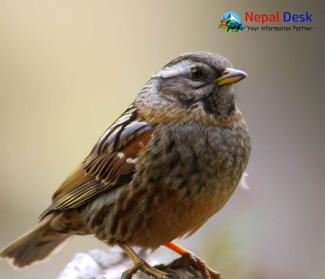One of the various fascinating species that can be found in the picturesque landscape of Nepal is the Alpine Accentor (Prunella collaris). It is a small passerine bird in the family Prunellidae. The robin-sized bird is slightly larger than its relative, the dunnock, and resembles a house sparrow. The Alpine accentor was described by the Austrian naturalist Giovanni Antonio Scopoli in 1769 and gave the name Sturnus collaris but is now placed in the genus Prunella that was introduced by the French ornithologist Louis Vieillot in 1816. The Alpine accentor, along with the Altai accentor is sometimes separated from the other accentors, into the genus Laiscopus.
Now, Let us look at the various facts and details of this tiny bird:
Adapting to the Alpine Environment
The Alpine Accentor is uniquely adapted to thrive in harsh, high-altitude environments. These small, sparrow-sized birds inhabit rocky terrains at elevations ranging from 9,000 to 18,000 feet. They withstand freezing temperatures, strong winds, and low oxygen levels – a true testament to their hardiness and will to survive.
Distinct Appearance and Behavior
Sporting a mix of gray-brown and chestnut-colored feathers, Alpine Accentors boasts a striking appearance that sets them apart from other birds native to Nepal. Their white streaks and characteristic throat patch make them easily identifiable among the sparse vegetation of their mountainous habitat. This friendly bird species often gather in flocks called "coveys," traveling and foraging together in search of food. Their diet mainly consists of insects, seeds, and occasionally fruit. During harsh winter months, they have been observed moving to lower elevations to escape the severe cold and search for sustenance.
Breeding Season: A Unique Courtship Ritual
The breeding season for the Alpine Accentor typically begins in early spring when snow starts melting at higher elevations. This enchanting bird has an unusual courtship ritual where multiple males sing melodious songs while fluttering around a female. The female then mates with multiple partners, producing an intriguing mating system known as polyandry.
Conservation Efforts: Safeguarding Their Future
While the Alpine Accentor population has been stable for many years, monitoring their numbers and protecting their habitat from human interference is crucial. Climate change and the resulting shifts in vegetation can have drastic effects on these birds, altering their food sources and overall survival.
Ecotourism plays a vital role in creating awareness about Alpine Accentors, as travelers from around the world come to Nepal to appreciate its stunning scenery and diverse wildlife. By supporting sustainable travel practices and conservation initiatives, we can ensure that this incredible bird species continue to thrive for generations to come.
In conclusion, the Alpine Accentor in Nepal is a remarkable testament to the wonders of Mother Nature. It is a fantastic example of how life adapts and evolves even in some of the harshest conditions on Earth. If you ever find yourself trekking through the awe-inspiring landscapes of the Himalayas, keep an eye out for these captivating little birds as they flit gracefully among the tenuous terrain. Their presence will undoubtedly add an unforgettable touch to your Himalayan adventure.




